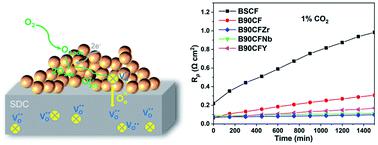当前位置:
X-MOL 学术
›
Sustain. Energy Fuels
›
论文详情
Our official English website, www.x-mol.net, welcomes your
feedback! (Note: you will need to create a separate account there.)
Trade-off between oxygen reduction reaction activity and CO2 stability in a cation doped Ba0.9Co0.7Fe0.3O3−δ perovskite cathode for solid oxide fuel cells
Sustainable Energy & Fuels ( IF 5.0 ) Pub Date : 2020-08-28 , DOI: 10.1039/d0se00878h Yi Lu 1, 2, 3, 4, 5 , Xinyu Zhao 1, 2, 3, 4, 5 , Zhihong Wang 4, 6, 7, 8 , Xifeng Ding 1, 2, 3, 4, 5
Sustainable Energy & Fuels ( IF 5.0 ) Pub Date : 2020-08-28 , DOI: 10.1039/d0se00878h Yi Lu 1, 2, 3, 4, 5 , Xinyu Zhao 1, 2, 3, 4, 5 , Zhihong Wang 4, 6, 7, 8 , Xifeng Ding 1, 2, 3, 4, 5
Affiliation

|
The excellent oxygen permeability of the perovskite BaCoO3 and its applicability as a cathode in solid oxide fuel cells are hindered by stability issues of carbonate formation in the presence of CO2, which degrades its excellent oxygen surface-exchange kinetics during the oxygen reduction reaction (ORR) process. In this work, we present a new type of Ba0.9Co0.7Fe0.2M0.1O3−δ (M = Zr, Nb, Y) perovskite oxide with high CO2 tolerance with respect to their original compound Ba0.9Co0.7Fe0.3O3−δ (B90CF) by doping cations at the B-site. These cathodes show low polarization resistances (Rp) of 0.0687, 0.0719, and 0.0853 Ω cm2 for Ba0.9Co0.7Fe0.2Y0.1O3−δ (B90CFY), Ba0.9Co0.7Fe0.2Zr0.1O3−δ (B90CFZr), and Ba0.9Co0.7Fe0.2Nb0.1O3−δ (B90CFNb) at 700 °C, respectively, which are comparable to B90CF (0.0655 Ω cm2). Moreover, after exposure to air containing 1% CO2 for 1500 min, the electrochemical impedance spectroscopy (EIS) test demonstrated the improved CO2 tolerance for the B90CFM cathode with Zr (Nb, Y) doping, where the Rp of B90CFZr only increased by 31%, ∼1/10 of that for B90CF. Barium carbonate on the B90CFZr cathode was obviously suppressed compared to B90CF according to SEM combined with EDS, XRD and FT-TR analysis. Doping high-valence metals at the B site of the B90CFM perovskite may increase the acidity on the surface and metal-oxygen bond free energy (〈ABE〉), leading to enhanced resistance to CO2. The trade-off between electrocatalytic activity and stability enable B90CFZr to be a promising cathode material for low and medium temperature SOFCs.
中文翻译:

固体氧化物燃料电池用阳离子掺杂的Ba0.9Co0.7Fe0.3O3-δ钙钛矿阴极中氧还原反应活性与CO2稳定性之间的权衡
钙钛矿BaCoO 3的优异的透氧性及其在固体氧化物燃料电池中作为阴极的适用性受到在CO 2存在下碳酸盐形成的稳定性问题的阻碍,这会降低其在氧还原反应过程中的优异的氧表面交换动力学( ORR)过程。在这项工作中,我们提出了一种新型的Ba 0.9 Co 0.7 Fe 0.2 M 0.1 O 3− δ(M = Zr,Nb,Y)钙钛矿氧化物,相对于其原始化合物Ba 0.9 Co 0.7 Fe 0.3具有高的CO 2耐受性O 3− δ(B90CF)通过在B位置掺杂阳离子来实现。这些阴极对于Ba 0.9 Co 0.7 Fe 0.2 Y 0.1 O 3− δ(B90CFY),Ba 0.9 Co 0.7 Fe 0.2 Zr 0.1 O 3− δ(B90CFY)表现出0.0687、0.0719和0.0853Ωcm 2的低极化电阻(R p)。B90CFZr)和Ba 0.9 Co 0.7 Fe 0.2 Nb 0.1 O 3− δ(B90CFNb)分别在700°C下与B90CF(0.0655Ωcm 2)。此外,在暴露于含1%CO 2的空气中1500分钟后,电化学阻抗谱(EIS)测试表明,掺杂Zr(Nb,Y)的B90CFM阴极对CO 2的耐受性有所提高,其中B90CFZr的R p仅增加降低了31%,约为B90CF的1/10。根据SEM,EDS,XRD和FT-TR分析,与B90CF相比,B90CFZr阴极上的碳酸钡明显受到抑制。在B90CFM钙钛矿的B位置掺杂高价金属可能会增加表面的酸度和金属-氧键自由能(〈ABE〉),从而提高对CO 2的抵抗力。电催化活性和稳定性之间的权衡使B90CFZr成为用于中低温SOFC的有希望的阴极材料。
更新日期:2020-09-29
中文翻译:

固体氧化物燃料电池用阳离子掺杂的Ba0.9Co0.7Fe0.3O3-δ钙钛矿阴极中氧还原反应活性与CO2稳定性之间的权衡
钙钛矿BaCoO 3的优异的透氧性及其在固体氧化物燃料电池中作为阴极的适用性受到在CO 2存在下碳酸盐形成的稳定性问题的阻碍,这会降低其在氧还原反应过程中的优异的氧表面交换动力学( ORR)过程。在这项工作中,我们提出了一种新型的Ba 0.9 Co 0.7 Fe 0.2 M 0.1 O 3− δ(M = Zr,Nb,Y)钙钛矿氧化物,相对于其原始化合物Ba 0.9 Co 0.7 Fe 0.3具有高的CO 2耐受性O 3− δ(B90CF)通过在B位置掺杂阳离子来实现。这些阴极对于Ba 0.9 Co 0.7 Fe 0.2 Y 0.1 O 3− δ(B90CFY),Ba 0.9 Co 0.7 Fe 0.2 Zr 0.1 O 3− δ(B90CFY)表现出0.0687、0.0719和0.0853Ωcm 2的低极化电阻(R p)。B90CFZr)和Ba 0.9 Co 0.7 Fe 0.2 Nb 0.1 O 3− δ(B90CFNb)分别在700°C下与B90CF(0.0655Ωcm 2)。此外,在暴露于含1%CO 2的空气中1500分钟后,电化学阻抗谱(EIS)测试表明,掺杂Zr(Nb,Y)的B90CFM阴极对CO 2的耐受性有所提高,其中B90CFZr的R p仅增加降低了31%,约为B90CF的1/10。根据SEM,EDS,XRD和FT-TR分析,与B90CF相比,B90CFZr阴极上的碳酸钡明显受到抑制。在B90CFM钙钛矿的B位置掺杂高价金属可能会增加表面的酸度和金属-氧键自由能(〈ABE〉),从而提高对CO 2的抵抗力。电催化活性和稳定性之间的权衡使B90CFZr成为用于中低温SOFC的有希望的阴极材料。











































 京公网安备 11010802027423号
京公网安备 11010802027423号